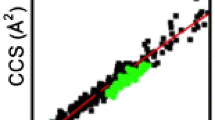Abstract
The degradation products of basic fibroblast growth factor (bFGF) were isolated by ion exchange HPLC (HP-IEC) and characterized. The predominant product at pH 5 was a succinimide in place of aspartate15 as determined by LC/MS, N-terminal sequencing, and susceptibility to degradation at pH >6.5. The rate of appearance of the succinimidyl-bFGF at 22 °C was comparable to that reported for small peptides, consistent with a high flexibility predicted for asp15-gly. Tryptic mapping together with [3H]-methylation indicated that iso-aspartate was formed at the position of asp15. Size exclusion HPLC indicated the presence of intact and truncated dimers and trimers which associated through disulfide linkages. Two truncated monomer forms were found that co-eluted by HP-IEC; the cleavages were determined to be at asp28-pro and asp15-gly using LC/MS and N-terminal sequencing. These degradation products which occurred at sites that are away from receptor or heparin binding domains of bFGF remained bioactive in a cell proliferation assay.
Similar content being viewed by others
REFERENCES
Y. J. Wang and M. Hanson. Parenteral formulations of proteins and peptides: Stability and stabilizers. J. Parenteral Sci. & Tech. 42:S1–S26 (1988).
T. J. Ahern and M. C. Manning (eds.). Stability of Protein Pharmaceuticals. Part A: Chemical and Physical Pathways of Protein Degradation. in Pharmaceutical Biotechnology, (R. Borchardt, series ed.), Vol 2, Plenum Publishers, 1992, pp. 1–238.
A. B. Robinson and C. J. Rudd. Deamidation of glutamyl and asparaginyl residues in peptides and proteins. Curr. Top. Cell. Regul. 8:247–295 (1974).
T. Geiger and S. Clarke. Deamidation, isomerization, and racemization at asparaginyl and aspartyl residues in peptides: succinimide-linked reactions that contribute to protein degradation. J. Biol. Chem. 262:785–794 (1987).
C. Oliyai and R. T. Borchardt. Chemical pathways of peptide degradation. IV. Pathways, kinetics, and mechanism of degradation of an aspartyl residue in a model peptide. Pharm. Res. 10:95–102 (1993).
M. Landon. Cleavage at aspartyl-prolyl bonds. Methods in Enzymology, 47:145–149 (1977).
C. Oliyai and R. T. Borchardt. Chemical pathways of peptide degradation. VI. Effect of primary sequence on the pathways of degradation of aspartyl residues in model hexapeptides. Pharm. Res. in press (1994).
G. Teshima, J. T. Stults, V. Ling, E. Canova-Davis. Isolation and characterization of a succinimide variant of methionyl growth hormone. J. Biol. Chem. 266:13544–13547 (1991).
B. N. Violand, M. R. Schlitter, E. M. Kolodziej, P. C. Toren, M. A. Cabonce, N. R. Siegel, K. L. Duffin, J. F. Zobel, C. E. Smith, and J. S. Tou. Isolation and characterization of porcine somatotropine containing a succinimide residue in place of aspartate129. Protein Science 1:1634–1641 (1992).
T. Tsuda, M. Uchiyama, T. Sato, H. Yoshino, Y. Tsuchiya, S. Ishikawa, M. Ohmae, S. Watanabe, and Y. Miyake. Mechanism and kinetics of secretin degradation in aqueous solutions. J. Pharm. Sciences 79:223–227 (1990).
S. A. Thompson, A. A. Protter, L. Bitting, J. Fiddes, J. A. Abraham. Cloning, recombinant expression, and characterization of basic fibroblast growth factor. Methods in Enzymology 198:96–116 (1991).
A. E. Eriksson, L. S. Cousens, B. W. Matthews. Refinement of the structure of human basic fibroblast growth factor at 1.6ÅA resolution and analysis of presumed heparin binding sites by selenate substitution. Prot. Science 2:1274–1284 (1993).
G. A. Eberlein, P. R. Stratton, Y. J. Wang. Stability of rhbFGF as determined by UV spectropscopic measurements of turbidity. J. Pharm. & Biomed. Analysis. in press (1994).
W. J. Henzel, J. T. Stults, C. A. Hsu, D. W. Aswad. The primary stucture of a protein carboxyl methyltransferase from bovine brain that selectively methylates L-isoaspartyl sites. J. Biol Chem. 264:15905–11 (1989).
M. V. Paranandi, A. W. Guzzetta, W. S. Hancock, and D. W. Aswad. Deamidation and isoaspartate formation during in vitro aging of recombinant tissue plasminogen activator. J. Biol. Chem. 269, in press (1994).
D. Gospodarowicz, S. Massoglia, J. Cheng, and D. Fuji. Effect of fibroblast growth factor and lipoproteins on the proliferation of endothelial cells derived from bovine adrenal cortex, brain cortex, and corpus luteum capillaries. J. Cellular Physiol. 127:121–136 (1986).
P. Skehan, R. Storeng, D. Monks, J. McMahon, D. Vistica, J. T. Warren, H. Bokesch, S. Kenny, and M. R. Boyd. A new colorimetric cytotoxicity assay for anticancer drug screening. J. Natl. Cancer Inst. 82:1113–1118 (1990).
A. DeLean, P. J. Munson, and D. Rodbard. Simultaneous analysis of families of sigmoidal curves: Application to bioassay, radioligand assay and physiological dose-response curves. Am. J. Physiol. 232:E97–E102 (1988).
Z. Shahrokh, V. Sluzky, P. R. Stratton, G. Eberlein, Y. J. Wang. Sulfated compounds promote disulfide-linked oligomerization of basic fibroblast growth factor. in ACS Symposium Series on Protein Formulation and Delivery. American Chemical Society Publishing. J. Cleland and R. Langer, (eds.), in press (1994).
R. Ragone, F. Facchinao, A. Facciano, A. M. Facciano, and G. Colonna. Flexibility plot of proteins. Prot. Eng. 2:497–504 (1989).
A. E. Eriksson, L. S. Cousens, L. H. Weaver, B. W. Mathews. Three-dimensional structure of human basic fibroblast growth factor. Proc. Natl. Acad. Sci. 88:3441–3445 (1991).
B. A. Johnson, J. M. Shirokawa, W. S. Hancock, M. W. Spellman, L. J. Basa, and D. W. Aswad. Formation of isoaspartate at two distinct sites during in vitro aging of human growth hormone. J. Biol. Chem. 264:14262–14271 (1989).
B. Violand, M. R. Schlittler, P. C. Toren, N. R. Siegel. Formation of isoaspartate99 in bovine and porcine somatotropins. J. Prot. Chem. 9:109–117 (1990).
J. Brange, L. Langkjaer, S. Havelund, A. Volund. Chemical stability of insulin. 1. Hydrolytic degradation during storage of pharmaceutical preparations. Pharm. Res. 9:715–726 (1992).
J. A. Schrier, R. A. Kenley, R. Williams, R. J. Corcoran, Y. Kim, R. P. Northey, Jr., D. D'Augusta, M. Huberty. Degradation pathways for recombinent human macrophage colonystimulating factor in aqueous solution. Pharm. Res. 10:933–944 (1993).
K. Sasaoki, T. Hiroshima, S. Kusumoto, K. Nishi. Oxidation of methionine residues of recombinant human interleukin 2 in aqueous solutions. Chem. Pharm. Bull. 37:2160–2164 (1989).
Author information
Authors and Affiliations
Rights and permissions
About this article
Cite this article
Shahrokh, Z., Eberlein, G., Buckley, D. et al. Major Degradation Products of Basic Fibroblast Growth Factor: Detection of Succinimide and Iso-aspartate in Place of Aspartate15 . Pharm Res 11, 936–944 (1994). https://doi.org/10.1023/A:1018962732067
Issue Date:
DOI: https://doi.org/10.1023/A:1018962732067




